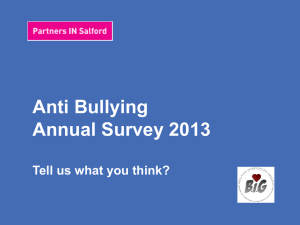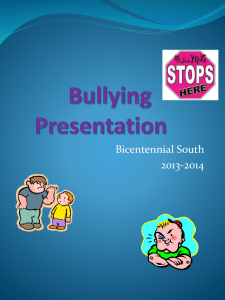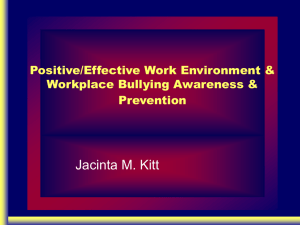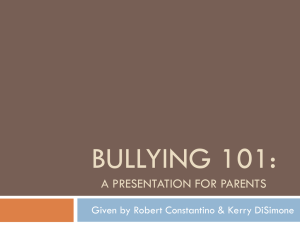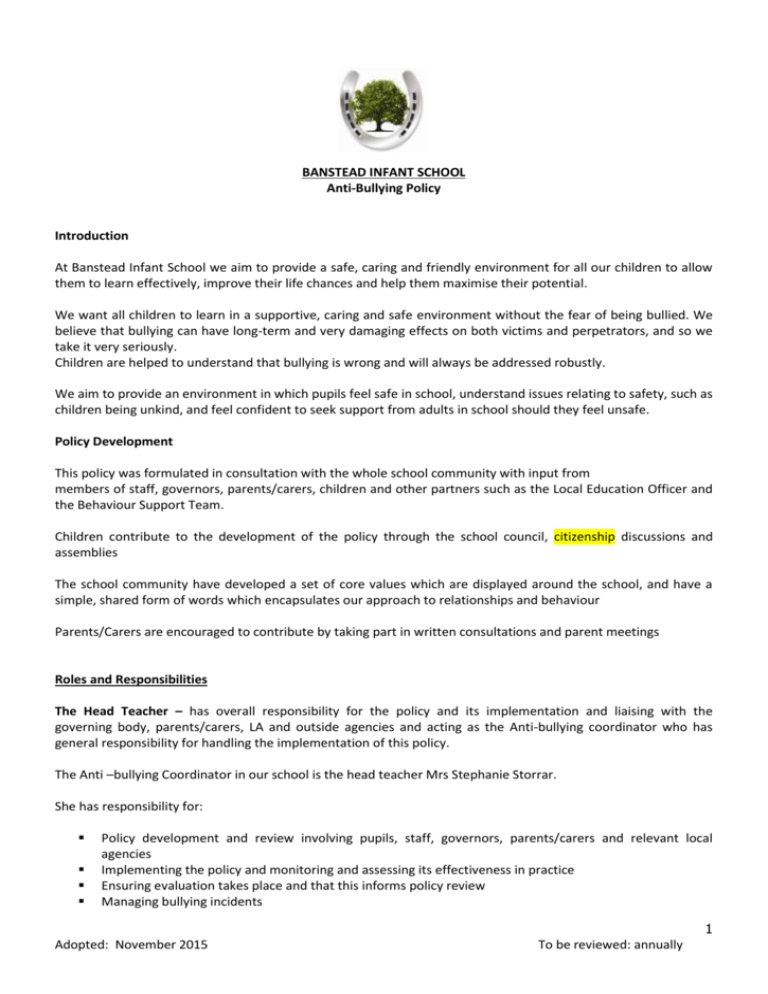
BANSTEAD INFANT SCHOOL
Anti-Bullying Policy
Introduction
At Banstead Infant School we aim to provide a safe, caring and friendly environment for all our children to allow
them to learn effectively, improve their life chances and help them maximise their potential.
We want all children to learn in a supportive, caring and safe environment without the fear of being bullied. We
believe that bullying can have long-term and very damaging effects on both victims and perpetrators, and so we
take it very seriously.
Children are helped to understand that bullying is wrong and will always be addressed robustly.
We aim to provide an environment in which pupils feel safe in school, understand issues relating to safety, such as
children being unkind, and feel confident to seek support from adults in school should they feel unsafe.
Policy Development
This policy was formulated in consultation with the whole school community with input from
members of staff, governors, parents/carers, children and other partners such as the Local Education Officer and
the Behaviour Support Team.
Children contribute to the development of the policy through the school council, citizenship discussions and
assemblies
The school community have developed a set of core values which are displayed around the school, and have a
simple, shared form of words which encapsulates our approach to relationships and behaviour
Parents/Carers are encouraged to contribute by taking part in written consultations and parent meetings
Roles and Responsibilities
The Head Teacher – has overall responsibility for the policy and its implementation and liaising with the
governing body, parents/carers, LA and outside agencies and acting as the Anti-bullying coordinator who has
general responsibility for handling the implementation of this policy.
The Anti –bullying Coordinator in our school is the head teacher Mrs Stephanie Storrar.
She has responsibility for:
Policy development and review involving pupils, staff, governors, parents/carers and relevant local
agencies
Implementing the policy and monitoring and assessing its effectiveness in practice
Ensuring evaluation takes place and that this informs policy review
Managing bullying incidents
1
Adopted: November 2015
To be reviewed: annually
Managing the reporting and recording of bullying incidents
Assessing and coordinating training and support for staff and parents/carers where appropriate
Coordinating strategies for preventing bullying behaviour
The nominated Governor with the responsibility for Anti-bullying (Behaviour) is the Chair of the Children and
Learning Committee, Peter High.
Definition of Bullying
The definition of bullying is agreed with the children and frequently revisited so that there is a shared
understanding. (See Appendix 1 for detailed definitions)
‘Bullying is behaviour by an individual or group, repeated over time, that intentionally hurts another individual or
group either physically or emotionally.’
‘Preventing and Tackling Bullying’ DfE’ October 2014
We say a child is being bullied or picked on when another child, or group of children, say nasty and unpleasant
things to him or her. It is also bullying when a child is hit, kicked, threatened, sent nasty notes or when no-one
talks to them. It is also bullying when a child is teased repeatedly in a nasty way.
How does bullying differ from teasing/falling out between friends or other types of aggressive behaviour?
There is a deliberate intention to hurt or humiliate.
There is a power imbalance that makes it hard for the victim to defend themselves.
It is usually persistent.
Occasionally an incident may be deemed to be bullying even if the behaviour has not been repeated or persistent
– if it fulfils all other descriptions of bullying. This possibility should be considered, particularly in cases of sexual,
sexist, racist or homophobic bullying and when children with disabilities are involved. If the victim might be in
danger then intervention is put into place immediately.
We have taken on the acronym STOP as given by the Anti-Bullying Alliance.
We have agreed that bullying is:
Several
Times
On
Purpose.
We teach children that bullying can take many forms (for example, verbal, physical, exclusion, cyber) and can be
directed at children who are perceived to be different in some way, and can thus be racial or homophobic.
We take a pro-active approach to bullying so that incidents are kept to a minimum. Bullying is discussed openly
during citizenship and assemblies, and children learn to value and respect differences in each other.
Recognising Bullying:
Children who are bullied may be reluctant to tell. When a disclosure is made, it is treated seriously and
investigated.
Signs of bullying might include:
•
unwillingness to come to school
•
withdrawn, isolated behaviour
•
complaining about missing possessions
•
refusal to talk about the problem
2
Adopted: November 2015
To be reviewed: annually
•
•
•
being easily distressed
damaged or incomplete work
incontinence
Reporting and responding to bullying
Where there are incidents, children learn the strategy:
Start
Telling
Other
People
Children learn that they must tell somebody if they are a victim of or a witness to bullying. In addressing the
issue, the behaviour is named as bullying, and we use a restorative justice approach so that both victim and
perpetrator are involved in exploring the background and agreeing the solution. Parents are also involved as
appropriate. If a child who is bullying does not respond to the restorative approach, sanctions will be imposed in
line with school policy in order to safeguard the victim, such as loss of the right to use the playground (see
Appendix 2 for details of support and restorative justice questions).
What does bullying look like?
Bullying can include:
name calling
taunting
mocking
making offensive comments
physical assault
taking or damaging belongings
gossiping and spreading hurtful and untruthful rumours
excluding people from groups.
Although bullying can occur between individuals it can often take place in the presence (virtually or physically) of
others who become the ‘bystanders’ or ‘accessories’.
Why are children and young people bullied?
Specific types of bullying include:
bullying related to race, religion or culture
bullying related to special educational needs or disabilities
bullying related to appearance or health
bullying relating to sexual orientation
bullying of young carers or looked after children or otherwise related to home circumstances
sexist or sexual bullying
There is no hierarchy of bullying – all forms are taken equally seriously and dealt with appropriately.
Bullying can take place between:
children
children and staff
between staff
individuals or groups
Any members of the school community, including parents and visitors
Reporting and Responding to Bullying
3
Adopted: November 2015
To be reviewed: annually
Our school has clear and well publicised systems to support the whole school community (including staff,
parents/carers, children and any other persons who may be affected), in the reporting of bullying. This includes
those who are the victims of bullying or have witnessed bullying behaviour (bystanders)
Children in school know that they must always tell an adult
Parents/carers should talk to the class teacher in the first instance
All staff and visitors should report concerns to a member of the Child Protection Team
Bystanders must always report what they have seen, as above.
Procedures
All reported incidents will be taken seriously and investigated fully, involving all parties to the incident.
All those involved are interviewed or complete a proforma (See Appendix 3)
Depending on the severity of the incident or its frequency, parents / carers of both victims and bullies
may be informed and encouraged to take part in target setting in order to obtain acceptable behaviour
usually by the class teacher and should receive feedback via the home/school diary.
The response aims to achieve a long-term resolution to the situation: it will be solution focused, taking a
restorative approach, and may include strategies such as circle of friends, individual work with those
involved, and if the incidents continue, further interviews/meetings /support counselling will take place
with both bully and victim. The SENCo will be involved. Additional external support may be sought via
outside agencies e.g. Educational Psychologist, Behaviour Support.
Sanctions will always be in line with those described in the Behaviour Policy. A serious case of persistent
bullying which is not resolved by the strategies outlined above may need to be addressed by exclusion.
Sanctions and the reasons for them in relation to the behaviour policy will be shared with all parties
involved. The bully should reassure the victim that it will not happen again and will be asked to apologise
verbally. Sanctions aim to improve the behaviour of those responsible and make the victim feel safe.
Feedback is given to concerned parties e.g. class teacher about the progress made as appropriate. A
'cooling off' time is given for children involved if appropriate.
The incident will be investigated quickly, fairly and positively– using the ‘no blame approach' - children
put forward their point of view without being accused - the bully, the victim and any witnesses will be
spoken to separately by an appropriate adult. If deemed necessary, discussions with both parties is
documented and kept on each child's PSHE tracking record.
Incidents are recorded and followed up, and the person managing the situation will maintain regular
contact with all those involved and, if it is not the Anti-Bullying Co-ordinator, will keep the ABC informed.
Support is given to the victim and the bully and anyone else who needs it. This could involve working
with the additional needs team or the head teacher.
The victim will be monitored to ensure that they feel safe and secure. The bully will be helped to
recognise their unacceptable behaviour and offered support to modify it. Subsequent behaviour will be
monitored. This may involve a Behaviour Plan, an action plan or social skills group.
All staff who come into contact with the bully and the victim will be made aware of the problem so that
they can monitor behaviour and ensure the safety of the child who has been bullied.
Recording Bullying and Evaluating the Policy
Bullying incidents are initially recorded by the member of staff who is dealing with the incident and this record
will be stored by the Anti-Bullying Coordinator in the behaviour log in the school office. (See Appendix 3)
The information stored is used to ensure individuals incidents are appropriately followed up. It is also used to
identify trends and inform preventative work in school and the development of the school’s policy.
This information is collated and presented without individual names to the governors as part of the annual report.
4
Adopted: November 2015
To be reviewed: annually
The policy will be reviewed and updated annually. The policy review will be linked to the Strategic Improvement
Plan, to support the school in further development of its inclusive ethos.
Strategies for Preventing Bullying
As part of our ongoing commitment to the safety and welfare of our children we have developed the following
strategies to promote positive behaviour and discourage bullying behaviour.
These include:
Weekly input of citizenship where we use the Nurturing Programme materials
Integration of SEAL materials
Involvement in Healthy Schools
Specific curriculum input on areas of concern such as internet safety
Student voice through the School Council
Playground Buddying
Parent information events/information
Staff training and development for all staff
Restorative Justice
Learning Mentoring by staff
Mediation through the Local Education Office
Links with other policies and documents
Behaviour Policy
Safeguarding Policy
Equalities Policy and Plan
PSHE and Citizenship Policy
Confidentiality Policy
E-Safety Policy
Preventing and tackling bullying DfE October 2014
5
Adopted: November 2015
To be reviewed: annually
Appendix 1
Definitions of the different types of bullying:
Physical Bullying: when a person uses overt bodily acts to gain power over peers and can include kicking,
punching, hitting or other physical attacks.
Verbal Bullying: when someone uses language to gain power over his or her peers. The verbal bully makes use of
relentless insults and teasing to bully his or her peers. For instance, a verbal bully may make fun of a peer's lack of
physical capabilities, may tease a peer for being "dumb" etc. and/or may call a peer names based on appearance.
Verbal bullies are one of the more difficult types of bullies to identify since their attacks tend to only occur when
adults are not present. Even though verbal bullying creates no physical damage, this type of abuse can have
lasting psychological impacts on victims.
Relational Bullying (R.A.): bullying common among teens, especially teen girls; an individual, or group try to hurt a
peer, or sacrifice another's standing within their peer group.
Cyber Bullying: use of technology to harass, threaten, embarrass, or target another person.
SEND Bullying (Special Education Needs or disabled children): research indicates that these children may be at
particular risk of bullying.
Sexist / trans-gender Bullying: The root cause of sexist and sexual bullying is gender inequality. Sexist, sexual and
trans-phobic bullying occurs when a pupil (or group), usually repeatedly, harms another child or intentionally
makes them unhappy because of their sex or because they may not be perceived to conform to normal gender
roles.
Homophobic Bullying: Any hostile or offensive action against lesbians, gay males, bisexual or transgender people,
or those perceived to be lesbian, gay, bisexual or transgender.
Racist Bullying: Any hostile or offensive action against people because of their skin colour, cultural or religious
background or ethnic origin.
Useful websites:
http://www.kidscape.org.uk/
http://www.anti-bullyingalliance.org.uk/resources/policy-guidance.aspx
6
Adopted: November 2015
To be reviewed: annually
Appendix 2
Support For The Child
Support through discussion and role models will be provided for the victim and the bully.
This will help both children understand:
What bullying is
Why children bully
Ways to avoid being bullied
Ways to stand up to bullies
What to do if it happens again
Making good choices
These points are shared with children:
Tell yourself you don’t deserve to be bullied
Try to show that you are not upset
Try being assertive - be clear that you don’t like what has been done/said and walk away quickly and
confidently
Stay with friends who you trust
Show that you and your friends disapprove and speak to them clearly that you are going to report their
bullying behaviour
Talk to a friend
Tell an adult
Give sympathy and support to a child who has been bullied
Be careful about teasing or making personal remarks that could be taken as bullying
Don’t stand by and watch - get help
Remember - we are all individuals and different
Restorative justice strategies/questions
What has happened? Listen to both points of view.
What’s the problem here?
Ask both/all disputants, ‘How does that make you feel?’
How do you think X is feeling? / Why do you think X is feeling like that?
What can you/we/your friends do to help X feel better/put things right?
What can you/we do to stop this from happening again?
Do you understand that if you keep hurting/teasing/being unkind to someone, even
after they have asked you to stop, then that is bullying?
Would you like this to be happening to you?
(To victim of unkind behaviour): If someone says or does this to you again, put your
hand up, palm facing them, and say in a firm voice, ‘Don’t say/do that, I don’t like
it/it hurts/it makes me feel sad!’ (Choose most appropriate phrase! Then get the
child to practise doing this.)
(To child accused of aggression/unkindness): If someone says to you ‘Don’t do that,
I don’t like it/it makes me feel sad’, what would you do?
Look at School Rules, identify and discuss with perpetrator which one they have
broken
It is our intention that by having these discussions, more than once if necessary, we can teach the children to
respect one another’s feelings and promote more peaceful playtimes.
7
Adopted: November 2015
To be reviewed: annually
Appendix 3
Banstead Infant School
Bullying Report
Date
Child affected
Reported by
Name of key adult involved
Children involved
What happened
Actions/strategies implemented
Parental involvement
Follow-up
Date resolved
Comments from children/parents involved
Signatures of all involved
8
Adopted: November 2015
To be reviewed: annually




